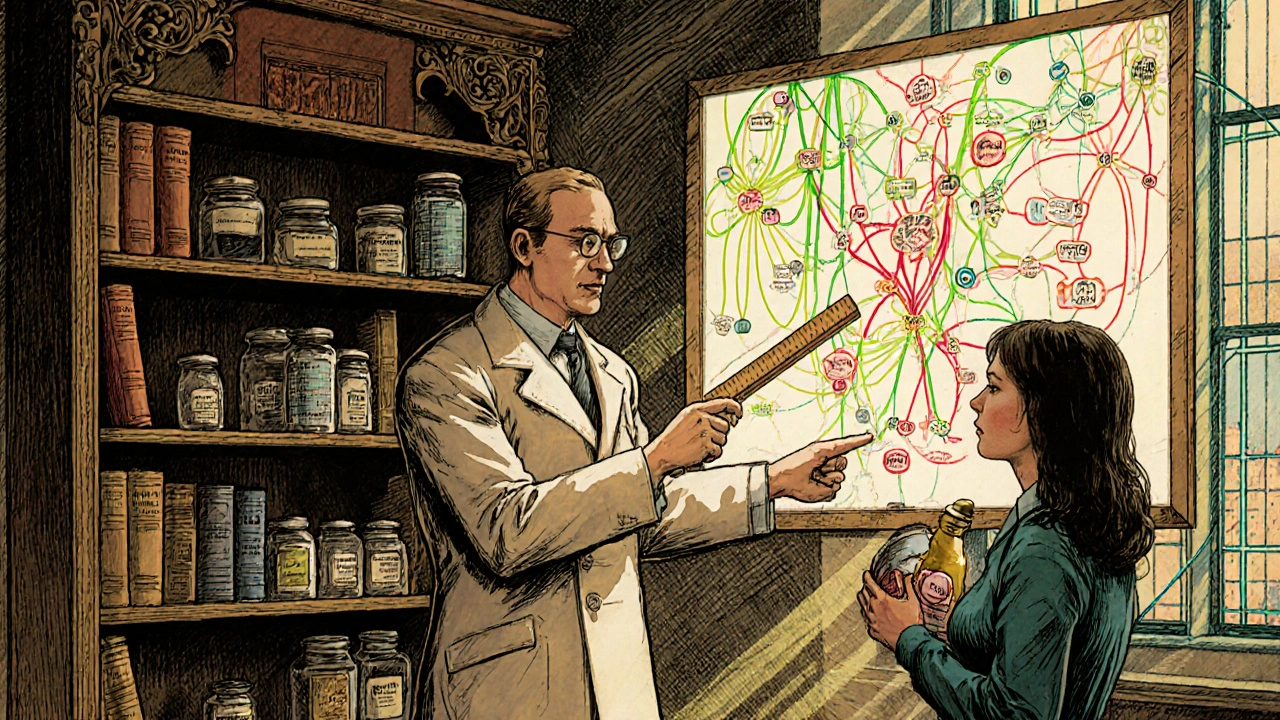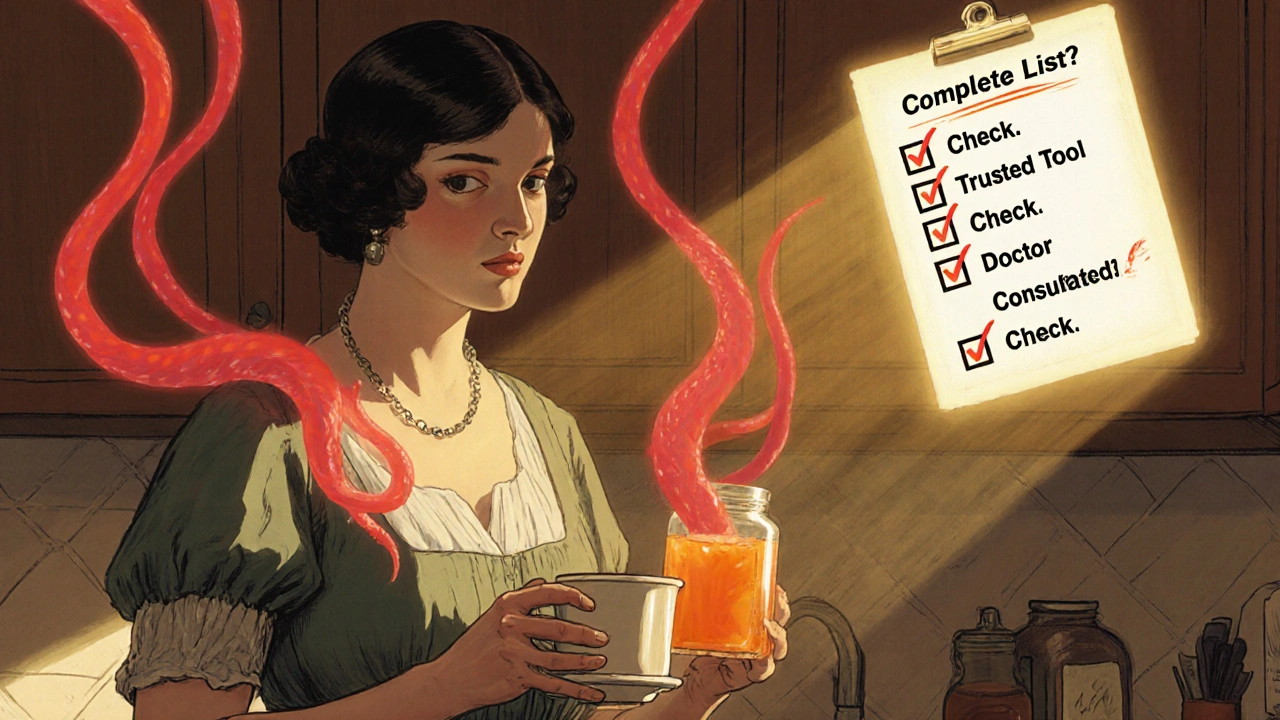How to Use Drug Interaction Checkers: Step-by-Step Guide
 Nov, 22 2025
Nov, 22 2025
Why Drug Interaction Checkers Matter
Every year, hundreds of thousands of people end up in the hospital because of dangerous drug combinations. Many of these cases are preventable. If you’re taking more than one medication - whether it’s prescriptions, over-the-counter pills, or even supplements - you’re at risk for an interaction that could make your treatment less effective, cause serious side effects, or even be life-threatening.
Drug interaction checkers are tools designed to catch these risks before they happen. They don’t replace your doctor or pharmacist, but they give you a powerful layer of protection. Think of them like a seatbelt for your medication routine. You wouldn’t drive without one. Why take pills without checking?
How Drug Interaction Checkers Work
These tools scan databases of known drug interactions. They look at how each medication is processed by your body, what enzymes it affects, and how it might react with others. Some checkers focus on common combinations, while others dig into rare but dangerous ones.
Results are usually color-coded or ranked by severity:
- Red = Avoid this combo. High risk of serious harm.
- Orange = Use with caution. Dose changes or monitoring may be needed.
- Yellow = Minor interaction. Watch for symptoms, but no major action required.
- Green = No known interaction.
Most tools also include short explanations. For example, if you check warfarin and ibuprofen together, it might say: “Increased risk of bleeding. Use acetaminophen instead.” Simple. Clear. Life-saving.
Step 1: Gather Your Medication List
Before you open any app or website, write down everything you take. Don’t skip the little stuff. That daily aspirin? The fish oil? The magnesium supplement? The herbal tea you drink for sleep? All of it matters.
Include:
- Brand names and generic names
- Dosage (e.g., 10 mg, 500 mg)
- How often you take it (once daily, twice a week, etc.)
- Route (oral, topical, injection)
Pro tip: Use your pharmacy’s printed list. Or take a photo of all your pill bottles. You’d be surprised how many people forget their blood pressure meds or forget they take melatonin every night.
Step 2: Choose the Right Tool
Not all checkers are the same. Here’s what works best for different users:
| User Type | Recommended Tool | Why It Works |
|---|---|---|
| General public / consumers | Medisafe | Simple app interface, syncs with your medication list, alerts you before you take a risky combo. |
| Healthcare professionals | Lexi-Interact or Micromedex | Used in hospitals, integrates with EHRs, more accurate for complex cases. |
| People on multiple chronic meds | DrugBank (web) | Handles supplements and rare drugs, gives detailed mechanism explanations. |
| COVID-19 or long-COVID patients | University of Liverpool DDI Checker | Specialized for antivirals, steroids, and immune-modulating drugs. |
For most people starting out, Medisafe is the easiest. It’s free, works on iPhone and Android, and lets you scan barcodes from your pill bottles.

Step 3: Enter Your Medications Accurately
Typing “ibuprofen” might not be enough. Some tools need the exact brand or formulation. If you’re using Plumb’s checker and type “Advil,” it might not recognize it unless you pick “ibuprofen 200 mg tablet.”
Always:
- Use generic names when possible - they’re more universally recognized.
- Check the dropdown menu carefully - don’t just pick the first match.
- Include supplements like St. John’s Wort, vitamin K, or garlic extract - these cause more interactions than people realize.
One user in Perth reported that their checker flagged a dangerous interaction between their blood thinner and a popular “natural heart health” supplement. Turns out, the supplement had high doses of vitamin K - which directly counters the drug’s effect. They never would’ve known without the checker.
Step 4: Review Results and Understand Severity
Don’t just glance at the colors. Click on every warning. The system might say “moderate interaction” - but what does that mean for you?
For example:
- If you’re on simvastatin (a cholesterol drug) and take grapefruit juice, the checker will warn you. Why? Grapefruit blocks the enzyme that breaks down simvastatin. This causes too much drug in your blood - increasing risk of muscle damage.
- If you take sertraline (an antidepressant) and dextromethorphan (a cough syrup), you could develop serotonin syndrome - a rare but deadly condition. The checker will flag this as red.
Some tools even explain what to do next. “Switch to a different pain reliever.” “Monitor for dizziness.” “Contact your doctor within 24 hours.”
Step 5: Take Action - Don’t Ignore Warnings
Here’s the hard truth: 49% of hospital staff ignore DDI alerts because they’re overwhelmed by false positives. But that doesn’t mean you should too.
If a checker flags a red interaction:
- Don’t stop your meds on your own.
- Don’t assume “it’s fine because I’ve taken them together before.”
- Call your pharmacist or doctor. Say: “I ran my meds through a checker and it flagged X and Y. Can we talk about this?”
Pharmacists are trained to interpret these alerts. They know which interactions are truly dangerous and which are just noise. They can suggest alternatives - like swapping ibuprofen for acetaminophen, or changing the timing of doses.
Common Mistakes People Make
Even with great tools, people still mess up. Here are the top 3 errors:
- Only checking prescriptions. Supplements and OTC drugs cause 30% of serious interactions. Don’t forget your multivitamin or turmeric capsules.
- Using outdated tools. Some free websites haven’t updated their databases since 2020. Stick to apps or platforms updated in 2023 or later.
- Assuming one tool is enough. Lexi-Interact and Micromedex are both highly accurate - but they catch different interactions. If you’re on 6+ medications, cross-check with two tools.

When to Trust the Checker - and When to Doubt It
Drug interaction checkers are smart, but they’re not perfect. They miss about 15-40% of real interactions, depending on the tool. Why?
- They don’t know your genetics. Some people metabolize drugs slower due to gene variants.
- They don’t know your liver or kidney function.
- They can’t account for alcohol use, smoking, or diet changes.
So use them as a safety net - not a crystal ball. Always combine the tool’s output with professional advice.
Real-Life Impact: What Happens When People Use These Tools
At Johns Hopkins Hospital, doctors reduced dangerous medication errors by 57% after training staff to double-check DDI alerts with a second tool. In a community pharmacy in Sydney, pharmacists reported a 68% drop in patient-reported adverse events after offering free interaction checks during pick-up.
One woman in Melbourne was on five medications for diabetes, high blood pressure, and arthritis. Her doctor didn’t realize she was also taking a popular joint supplement. The checker flagged a dangerous interaction between her blood thinner and the supplement’s ingredient - glucosamine combined with chondroitin. She switched supplements, and her INR levels stabilized within weeks.
What’s Next for Drug Interaction Checkers
The next generation of tools will use your genetic data, real-time lab results, and even your sleep and diet patterns to predict risks. Mayo Clinic is already testing systems that adjust interaction alerts based on kidney function - something current tools can’t do.
By 2027, most hospital systems will automatically check your meds before a new prescription is written. But until then, you’re your own best advocate.
Final Checklist: Use This Before Taking Any New Med
- ☐ I have a complete list of everything I take - including supplements.
- ☐ I used a trusted, up-to-date interaction checker (Medisafe, DrugBank, or Lexi-Interact).
- ☐ I reviewed all warnings, not just the red ones.
- ☐ I contacted my pharmacist or doctor about any flagged combo.
- ☐ I didn’t assume “it’s fine because I’ve taken it before.”
Medication safety isn’t about being paranoid. It’s about being smart. A few minutes using a drug interaction checker can save you a hospital trip - or worse.

Pallab Dasgupta
November 23, 2025 AT 14:56Ellen Sales
November 24, 2025 AT 04:49Agastya Shukla
November 24, 2025 AT 05:25Josh Zubkoff
November 24, 2025 AT 16:48fiona collins
November 24, 2025 AT 22:20Rachel Villegas
November 25, 2025 AT 08:55giselle kate
November 26, 2025 AT 23:33Emily Craig
November 27, 2025 AT 03:17Karen Willie
November 28, 2025 AT 06:49Leisha Haynes
November 28, 2025 AT 07:03Shivam Goel
November 29, 2025 AT 09:23Amy Hutchinson
December 1, 2025 AT 05:46Archana Jha
December 3, 2025 AT 04:28Aki Jones
December 3, 2025 AT 22:17Jefriady Dahri
December 3, 2025 AT 22:46Andrew McAfee
December 5, 2025 AT 13:21Andrew Camacho
December 6, 2025 AT 12:00